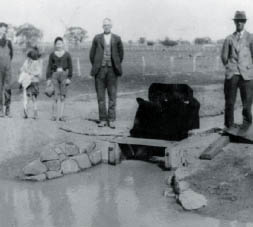 |
 |
|
Work begins
In the early 1900s the State Government began acquiring and subdividing land to encourage the closer settlement of inland and southern NSW. In the Murrumbidgee region small blocks of land, complete with irrigation infrastructure, were offered to landholders. Water conservation and irrigation schemes were operating in this region as early as 1912, but irrigation was still more than two decades away for the southern Riverina. Hume Dam was one of the first promised water conservation works in the Murray River Agreement and work began in 1919. At this time a new wave of settlers – ex-servicemen returning from the World War I – began taking up land in the south. But without regular water supplies the struggle was too much for some. Another serious drought in the 1920s led many to simply walk off their land. By 1926 landholders in the Barham~Wakool region had developed a detailed proposal for irrigation in their area. In 1928, following intense lobbying, the Government announced that a development based on this landholder proposal would go ahead, when funds became available. The scheme required a weir 15 miles west of Deniliquin to hold up the level of the Edward River. This would allow water to be channelled through the Colligen Creek and from there into the proposed irrigation network. Major public works projects such as the weir and irrigation network offered some relief to the record unemployment of the Depression during the early 1930s. The weir is named after NSW Premier Bertram Stevens who turned the first sod for construction in 1933. The Wakool system and weir were completed in 1938. |
First water delivered
The first water was supplied to farmers through the new channel system in the Wakool Irrigation District in September 1935. The Wakool scheme was the first to make any significant use of the NSW share of water from the Murray River system. |
|
| sitemap • credits
& references • copyright • local
history links • contact & contribute • VISITORS |
||

